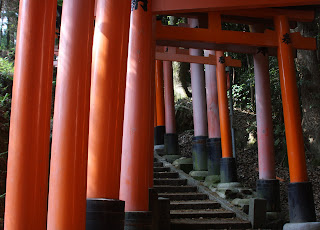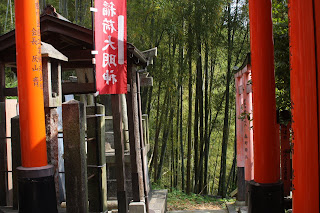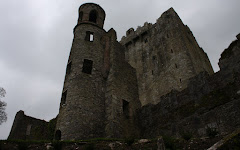Theresa—a friend and colleague who has lived in Japan FIVE years, who has received a transfer to Sigonella and will move to Sicily this upcoming summer, and who had never been to Kyoto either—and I rendezvoused at the Yokosuka-chuo train station early Saturday morning, just as train service began for a new day, so we could train it to Tokyo’s Shinagawa station. There we would connect with the Shinkansen, perhaps more famously termed the “bullet train,” headed to Kyoto. It would be the first trip on the Shinkansen for both of us as well.


Japan—beyond the vast sprawl of the Tokyo/Yokohama metropolis, a sprawl that long ago annexed Yokosuka, the city where I reside—still displays the sizes, shapes, and colors of the Japanese signature style of construction: cramped, functional, and largely aesthetically unsatisfying. The difference is that outside of its major cities Japan looks like pieces of a puzzle picture of Yokosuka dispersed across a table surfaced in rice paddies. (A rice paddy in my area is rare, miniscule, and always singular in number.)
That said, Kyoto is a truly Japanese city while Tokyo is an international city. And, despite all of its modern functionality, pockets of “old Japan” continue to exist within Kyoto. Along with the Gion district—think geishas—all manner of Buddhist temples and Shinto shrines, castles and palaces, have sites within the space of Kyoto. Nijo Castle, with its “nightingale floor,” and Fushimi Inari Taisha, with its thousands of torii gates, were my favorites of the places we visited.
Originally constructed in the seventeenth century as the official Kyoto residence for a Shogun, Nijo Castle is comprised of several buildings, including a palace where the Shogun actually lived. The palace has the “nightingale floor”—a floor that squeaks/chirps/sings like a nightingale when you walk on it. It was designed to help protect the Shogun from assassination, especially by ninjas! And, yes, shoguns, samurai, and ninjas are true characters in the story of Japan! No matter how quiet the footstep, the transfer of weight makes the floor sing. It is just so amazingly cool!
(DISCLAIMER: Because no photos are allowed to be taken inside the buildings, I have only exterior shots of Nijo Castle.)




Dedicated to the fox—farmers believed foxes were messengers of the harvest god—the shrine in Fushimi actually has over 10,000 torii covering the paths of various “philosopher walks” up and down a bamboo forested hillside. It, too, is way cool!
(That's Theresa philosophizing as she walks!)




If any of you will come visit me in Japan this next year, I promise to take you to Kyoto. Then you, too, can traipse across the “nightingale floor,” composing nightingale songs, and meander through tunnels of torii gates inside a bamboo forest.






























1 comment:
I would love to come to Japan. I tend to pay for times I choose to take financial risk for adventure however.
Post a Comment